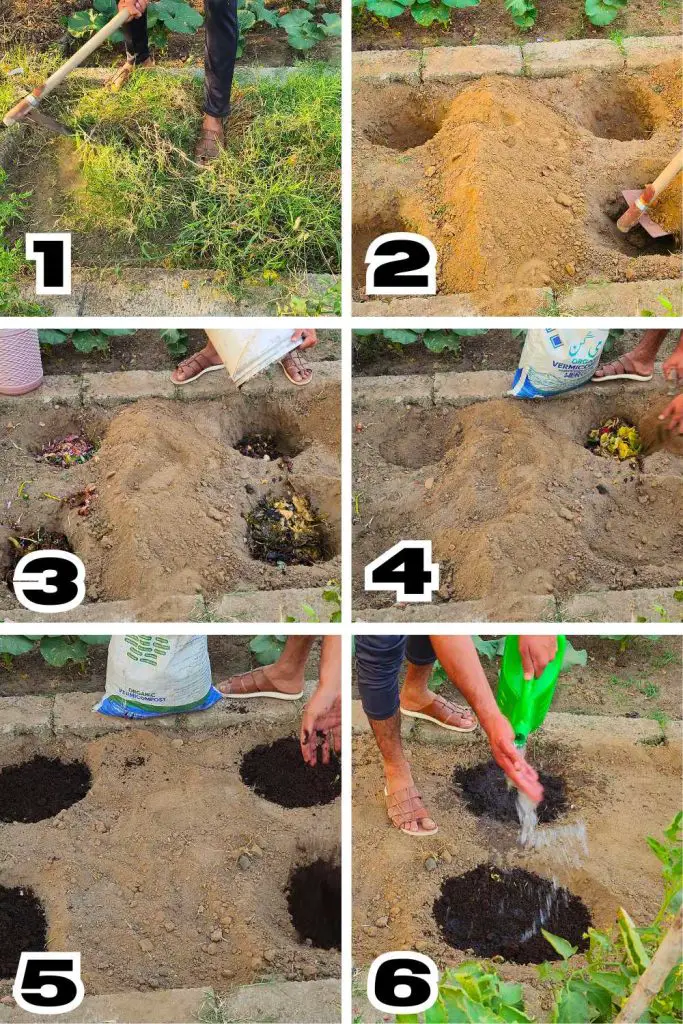If you’re looking to grow healthy, nutrient-rich vegetables, the first thing you need to do is prepare your garden bed properly. In this article, we will show you step-by-step how to tackle Bermuda grass, one of the worst weeds in gardening, and turn your garden bed into a thriving space full of nutrients for your plants. We’ll also cover how kitchen waste and worm castings can help feed your plants for months, making them stronger and healthier.

Clearing the Bed from Bermuda Grass
The first step in preparing your garden bed is to clear it from any weeds. One of the most stubborn and frustrating weeds you’ll find is Bermuda grass. This type of grass spreads quickly, grows back easily, and sends its roots deep into the soil. It can be a nightmare for gardeners because it competes with your vegetables for nutrients, water, and space.
To get rid of it, you need to pull up as much of the grass as possible, making sure to remove the roots too. If you leave the roots behind, the Bermuda grass will just come back, and you’ll have to deal with it again. You can also use a hoe or a weeding tool to dig deep and ensure that no roots are left behind. The more thorough you are with this, the better your garden bed will be for planting.
Digging Big Holes for Your Vegetables
Once the weeds are removed, it’s time to dig the holes for your vegetables. It’s important to dig big holes rather than small ones. The bigger the hole, the more space there will be for your plants to grow and spread their roots. It also allows you to add more organic material, which will help feed your plants.
Digging deep holes ensures that the roots have plenty of room to grow, which will help them absorb nutrients and water from the soil more effectively. Once the holes are ready, you’re good to move on to the next step.
Using Kitchen Waste to Boost Soil Health
Now comes the exciting part! We’re going to use kitchen waste to feed our plants. But don’t just throw any waste into the hole. You should use plant-based kitchen waste such as vegetable peels, fruit scraps, coffee grounds, and crushed eggshells.
These types of scraps break down naturally and turn into compost, which is full of essential nutrients like nitrogen, phosphorus, and potassium. These nutrients are perfect for feeding your vegetables and helping them grow strong.
It’s important to only use plant-based kitchen waste because it decomposes much more easily and doesn’t attract pests like cooked food, meat, or dairy products would. Adding this waste to the holes will provide your plants with a steady supply of nutrients over time, without needing to rely on chemical fertilizers. As the kitchen waste breaks down in the soil, it will release the nutrients slowly, which means your plants will continue to get food for months.
Covering the Kitchen Waste with Soil
After placing your kitchen waste in the hole, you need to cover it with the same soil you dug out earlier. This is an important step because it helps prevent bad smells and keeps the kitchen waste hidden from pests. The soil also helps create the right balance of moisture and air for the waste to break down properly. This process helps improve the soil’s structure, making it more crumbly and loose.
This loose soil makes it easier for water to drain, but it still holds enough moisture for your plants. As the kitchen waste decomposes, it will add even more organic matter to the soil, further improving its health and fertility.
Adding Worm Castings for Extra Nutrients
After you’ve covered the kitchen waste with soil, the next step is to add worm castings. Worm castings are one of the best natural fertilizers you can use in your garden. They are rich in nutrients like calcium, potassium, and magnesium, and they help improve the soil structure by making it more aerated. This means the roots of your plants can access the nutrients and water more easily.
Worm castings also contain beneficial microbes that can help protect your plants from diseases and boost their immune systems. These microbes work to break down organic matter in the soil, releasing nutrients that plants need to grow. One of the best things about worm castings is that they release nutrients slowly over time, which ensures your plants have a steady supply of food for weeks or even months.
Watering the Holes
Once the kitchen waste and worm castings are in place, it’s time to water the holes. Watering is a very important step because it helps settle the soil and ensures that the nutrients from the kitchen waste and worm castings begin to mix into the soil.
It also helps kick-start the decomposition process, which is essential for feeding your plants. Give each hole a generous amount of water to make sure everything is well-moisturized. Watering will also help the soil settle down around the roots, making it easier for your plants to grow.
Planting Your Vegetables
Now that your garden bed is prepared, it’s time to plant your vegetables. The roots of your plants will grow deep into the holes that you’ve prepared, where they will find a rich supply of nutrients and organic matter to support their growth.
This method of using kitchen waste and worm castings ensures that your plants will get all the food they need for the first few months without the need for chemical fertilizers. It also improves the soil’s long-term health by adding organic matter, which helps maintain good soil structure and moisture retention.
By planting right away, you’re setting your vegetables up for success. The combination of nutrients, moisture, and healthy soil will help them grow strong, green, and productive. Plus, using kitchen waste and worm castings is a great way to recycle, turning things that would have gone to waste into something useful for your garden.
The Benefits of Using Natural Fertilizers
Using kitchen waste and worm castings has many benefits. First, it helps reduce waste, which is good for the environment. By composting kitchen scraps, you’re preventing them from ending up in a landfill where they would contribute to pollution.
Second, it provides your plants with all the nutrients they need in a natural and organic way. No harmful chemicals are involved, making this method safe for both your plants and the environment. Lastly, it improves the overall health of your garden. Healthy soil leads to healthy plants, which in turn produce better vegetables.
